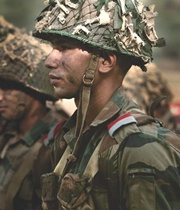India carries out ‘surgical strikes’ across LoC, 38 militants killed
29 Sep 2016
Nearly 10 days after the Uri attack that claimed the lives of 18 Indian soldiers, India carried out surgical strikes in Pakistan Occupied Kashmir, inflicting heavy casualties on terrorists and ''those protecting them''.
 This indicates a sharp change of India's stand on the rules of engagement on the disputed Line of Control.
This indicates a sharp change of India's stand on the rules of engagement on the disputed Line of Control.
Director General of Military Operations Lt Gen Ranbir Singh announced that Pakistan had been informed about the strikes and that India has no intention of continuing the operations but is ready for any reaction from the Pakistani side.
The BSE Sensex dipped over 500 points after the Army announcement, indicating some fear in the markets about further developments.
The strikes, the first of their kind across the Pakistani border during peacetime, were based on specific intelligence, reports say.
Thirty-eight terrorists and 2 Pakistani soldiers were reported killed in the Indian Army strikes, with no Indian casualties. Those killed included terrorists, their guides and handlers. Seven terror attack launch pads were destroyed during the strikes.
The operation began around 12.30 am on Wednesday. According to reports, paratroopers from special forces were involved. The commandos were airdropped at the LoC, from where they crossed over to the Pakistani side.
According to reports, Indian commandos entered three kilometres across the Line of Control to conduct the 'surgical strikes'. The strikes were carried out in Bhimber, Hotspring, Kel and Lipa sectors on Pakistan's side of the LoC, according to Pakistan's Inter Services Public Relations.
The location was 500 metres to two kilometres across the LoC, reports said. Helicopters were used. The mission, according to reports, ended at 4.30 am
The option of surgical strikes was taken in the wake of an increase in infiltration attempts, the DGMO said. Terrorists had begun gathering in large numbers along the LoC with the objective of crossing the border and targeting locations in Jammu and Kashmir, as well as other metros. In such a scenario surgical strikes were considered the best option.
Kel and Lipa are both known to be significant launching stations for the Lashkar-e-Taiba (LeT) and other terrorist groups where small units of jihadists gather near military forward posts for the last stage of their journey across the LoC into northern Kashmir. Bhimber, similarly, is a major axis of infiltration into Rajouri and Poonch.
India and Pakistan had agreed to a ceasefire along the Line of Control in 2003, following the India-Pakistan military crisis that followed the Jaish-e-Muhammad's attack on Parliament House on 31 December 2001. However, efforts to arrive at a formal signed agreement stalled in 2006, following disputes over the rules governing new defensive fortifications.
Ever since the long jihad in Kashmir began in 1989, troops on both sides of the LoC have been locked in an often-savage secret war which General Singh's press conference has for the first time brought out into the open. History suggests that the fighting on Thursday is unlikely to be the end of the story.
Pak in denial
Pakistan's military said that two of its soldiers were killed when troops ''exchanged fire across the Line of Control'' in an engagement which began at 2:30 am and ended at 8:00 am. In a later statement, it denied any strikes had taken place across the Line of Control (LoC), saying instead that there had been ''cross-border fire initiated and conducted by India which is an ''existential phenomenon''.
''Our desire for peace should not be interpreted as our weakness,'' said Pakistan Prime Minister Nawaz Sharif.
Surgical strikes are military operations undertaken by forces across the world to move on the offensive, hit enemy targets and installations, and return to primary positions, all with lightening speed and with the added precaution of suffering limited casualty
Such strikes require not just detailed and exhaustive planning but need to be carried out with absolute precision to achieve the objective of taking down targets with either no or minimal collateral damage.













.jpg)






.jpg)









